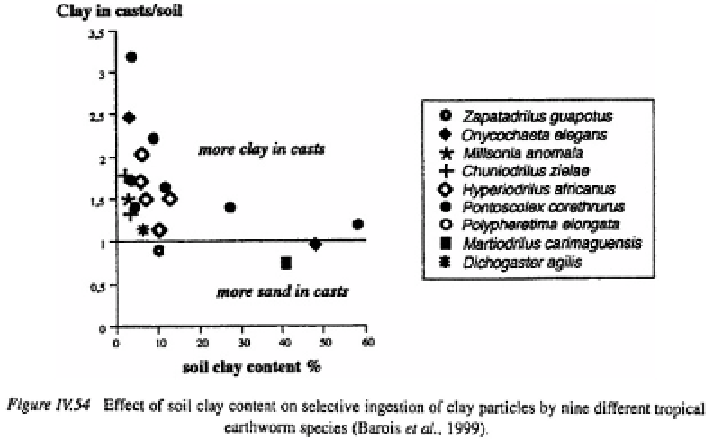Agriculture Reference
In-Depth Information
Soil aggregation
Endogeic earthworms may annually ingest the moist equivalent of several hundred to
more than one thousand Mg dry soil per hectare (Lavelle, 1978; Boström, 1988). In four
arable soils with, respectively, unfertilised and fertilised barley, grass and lucerne crops,
annual cast production by
Aporrectodea caliginosa
was estimated to be between 36 and
of which 20 to 50 % was deposited at the soil surface. In humid tropical
grasslands, endogeic earthworms may ingest daily 5-6 (
Pontoscolex corethrurus
) and
up to 25-30 (
Millsonia anomala)
times their own weight of soil (Lavelle, 1975; Lavelle
et al.,
1987). Overall annual cast production may therefore commonly range from
several hundreds to a maximum of 1250 Mg per hectare. As indicated above, only
a small proportion of these casts (5 to 20 % depending on species) are deposited at
the soil surface and subterranean casts form the component units of stable macro-
aggregate structures (Figure IV.52).
Experiments have demonstrated that such structures may be built in surprisingly
short periods of time suggesting that factors other than the simple production of
globular casts contribute to aggregation. Blanchart
et al.,
(1989) found that in 33 days,
the activity of 5 g of
Millsonia anomala
resulted in the formation of 2883 g of aggre-
gates (
i.e.,
42.4 % of the soil in the experimental container), as compared to 906 g
(13.3 %) in a control treatment and 1075 g (15.8 %) in a treatment with the grass
Panicum maximum.
Cast production by the earthworms was estimated at 1815 g, that is,
26.7 % of the aggregates formed; the remaining 15.7 % may have resulted from the pro-
liferation of fungal hyphae, perhaps those of mycorrhizal fungi associated with the roots.
Similar levels of aggregation have been obtained with the endogeic earthworm
Aporrectodea caliginosa
(Hopp and Hopkins, 1946). After four days, two worms kept
in 75g of soil had formed 11.6 g of stable aggregates (15.5 %)
i.e.,
more than three times
the control without worms.


